
“The Singapore economy outperformed expectations,” reported the Straits Times on 5 January 2017. The economy was said to have expanded by “1.8 per cent in the fourth quarter of 2016 from a year earlier, putting growth for the whole of 2016 at 1.8 per cent, according to advance estimates from the Ministry of Trade and Industry…”
Without questioning how earlier forecasts were developed, the newspaper wrote, “Growth last year was well above MTI’s earlier announced forecast of 1.0 to 1.5 per cent.” I couldn’t but suspect that the ministry had long ago prepared for this day by massaging expectations downwards. I think they do that year after year; it’s getting old.
A decade or two ago, a GDP increase of 1.8 percent would be considered terrible. But of course, such comparative recall would be unwelcome. Nor would it be welcome to point out that it’s the slowest rate of growth since 2009 when, in the throes of the Great Recession, our economy slipped 0.6%. Nowadays, 1.8 percent is to be taken as cause for celebration (“outperformed”) and further proof of the competence of the People’s Action Party government.
For a better fix on the situation, we should see how Singapore compares with our trade neighbours, particular those at roughly the same income and technology level. However, it’s too early to do that, as other countries may not have released their 2016 estimates yet.
Nine years’ GDP data
As an alternative, I decided to look at longer-term data. From the World Bank website, I obtained the numbers for the table below (with the exception of the Taiwan numbers which were from the Taipei government’s statistics website).
The countries are grouped by their per capita GDP. The conventional wisdom is that it is easier for less-developed countries to achieve high rates of GDP growth — though I am not sure how solid the theoretical grounding is for this belief — so in the comparative analysis to follow, we will apply this way of grouping them.
Before we leave the table above, I want to draw your attention to the compounded increase in GDP (second column from right) over the nine-year period. Singapore shines (54.4% compound increase) when compared to other economies in the same income bracket, though not so much when compared to the poorer countries.
Now let’s look more closely at these 13 countries by group. In the first graph, I show you the countries with per capita GDP above US$20,000:
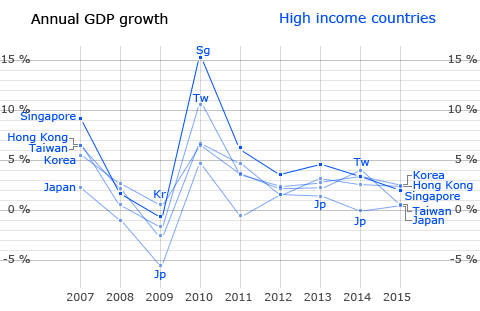
Over those nine years, Singapore tended to have the highest growth rates compared to Japan, South Korea, Taiwan and Hong Kong. Japan is clearly in a funk. Another thing that is striking is how synchronised these export-led economies are.
The second graph shows you Singapore compared to the middle-income countries, i.e. those with GDP between US$5,000 to US$10,000 per head:
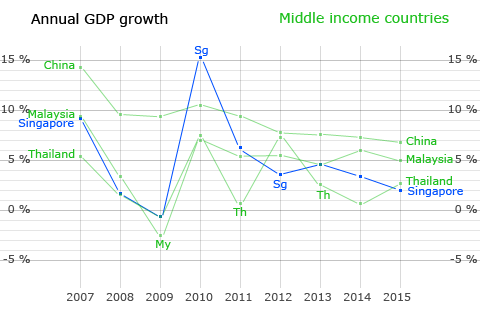
We don’t look outstanding compared to this lot. On the other hand, it is China that steals our attention, not only for its relatively high growth rates but by how steady they are through the years (albeit gradually softening).
The third graph compares us to Indonesia and the Philippines, with per capita GDP between US$2,500 and US$5,000:
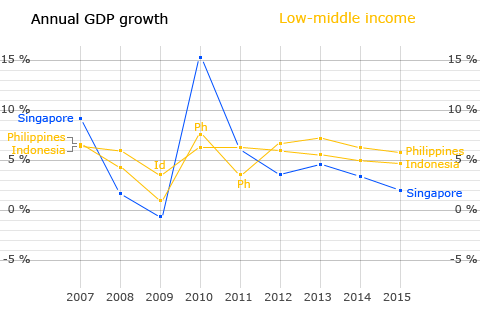
For six of these nine years, Singapore was the laggard. Overall, these two economies have been catching up with us during this period. But of course we are reminded that getting growth is easier when one is starting from a low base.
The fourth group has three countries whose per capita GDP is under US$2,500:
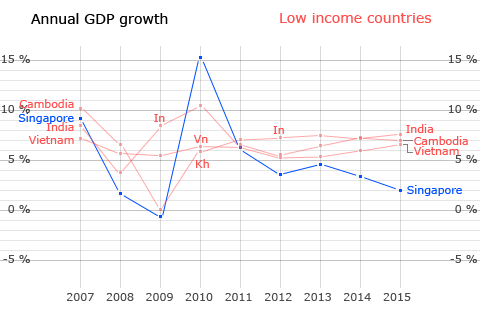
Except for 2010 when Singapore was rebounding from a deep trough the year before, these countries’ economies have consistently performed better than Singapore’s.
The general conclusion is that whilst our economic performance might be slightly better than our high-income peers, it is not impressive when seen against middle and lower income countries of the region.
Adjusting for population growth
Bear in mind that these are crude comparisons. They can do with refinements in many ways. One easy step is to take into consideration population growth. Just adding bodies to an economy generates economic activity. The added humans need to eat, for example. When they go to a market to buy things, they create economic activity. The sellers’ sales will increase, which will ripple through their supply chains.
From the World Bank (in the case of Taiwan, from other internet sources) we obtain the population data for 2007 and 2015 — the start and end of the period in our analysis.. What is striking is how Singapore has had the biggest increase in population, percentage-wise.
What I did next was to
- import (into the second column from right) the compounded “% increase in GDP” from the topmost table;
- discount the % GDP increase by the % population increase.
The right-most column thus gives us a hypothetical approximation of the increase in GDP over nine years if each country’s population had remained static. I want to stress that although the numbers appear to have decimal places, there is nothing accurate about this approach. There is no easy way to strip the effects of population changes from GDP growth; economies are highly complex mechanisms. So don’t impute any precision to these adjusted numbers; just use them as indicative estimates.
That said, you can see, our 54.4% increase in GDP (2007 – 2015) — significantly higher than other high-income countries — is much reduced as a result of this tweak. After adjustment for population growth, our cumulative GDP growth appears to be in the same ballpark as Taiwan’s and South Korea’s.
It is also significantly lower than all the other middle and low income countries, with the exception of Thailand.
Thailand, as you may know, has had a rough time politically. Beginning with the Red Shirts and Yellow Shirts fighting it out in the streets of Bangkok and other cities, followed by numerous changes of government and then a coup, it’s almost a miracle that their economy grew as much as Singapore’s in this stripped-of-population-growth comparison.
Now I will come to my chief point.
Fearing instability

Korean railway workers on strike in Seoul central station
Ever since the 1960s, the People’s Action Party has demanded an implicit contract from the people of Singapore: Sacrifice some civil rights and political freedoms so that the economy can roar ahead. Perhaps it made sense in those decades, but this is not the place to debate it. Since then, there have been huge changes in the domestic and external economic environments, and even greater changes in technology. Yet, this demand is still being made of Singaporeans.
My point here is that if we looked at Singapore’s economic performance relative to other countries in a similar income class, there has been no “roaring ahead” in the last nine years. We’re not doing demonstrably better than Taiwan and Korea despite their turbulent democracies, protests, strikes and impeachments and jailings of presidents. We only look like we’re doing better because we have been pushing population growth through immigration, which brings its own social stresses. Even then, we can’t be sure that after factoring income inequality — a further refinement I didn’t make to the data — we would still look as good as we do compared to our high-income peers.
The other day, a friend mentioned to me how disappointed he was with his former classmates from Raffles Institution, a premier school in Singapore. Many have climbed to high positions in business and the professions since they left school. At the last general election, they told my friend they were leaning towards voting for opposition parties, but at the last minute, in the polling station, they changed their minds. “They said they were concerned about instability,” my friend told me.
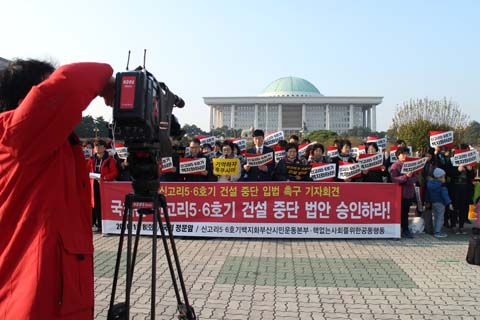
Demonstration in front of the Korean National Assembly building, with media coverage
What the data above shows is that despite “instability”, Taiwan and Korea have done about as well as Singapore over the last nine years. Even Thailand!
Taiwan and Korea are robust democracies. Their citizens enjoy far more civic freedoms than we do. But we’ve been told that Singapore cannot afford these “luxuries”. We have to put up with soft authoritarianism, as well as the social dislocation of massive immigration — otherwise our economy will go down the chute. We have to put up with million-dollar salaries for ministers, because without such incentives, they cannot do their superlative job of delivering fantastic growth.
The numbers, however, tell a different story.
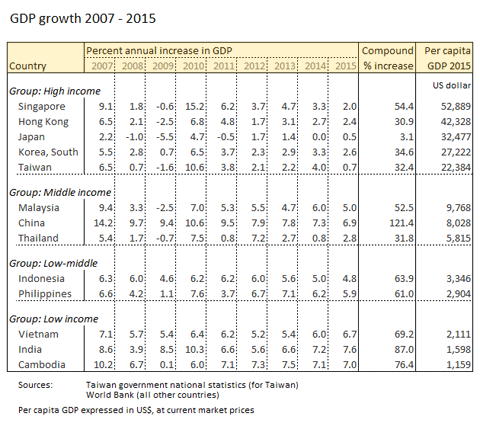
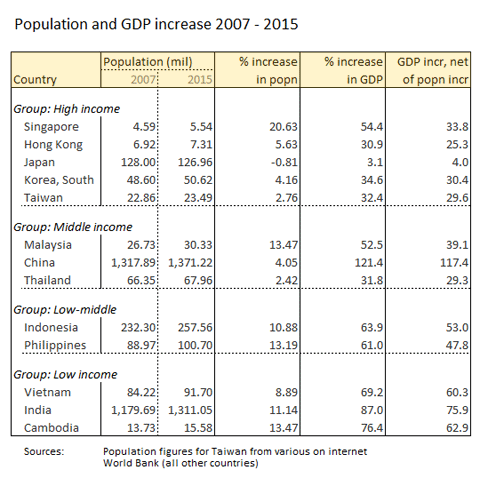


0 Responses to “Did we get more economic growth by giving up our freedoms?”